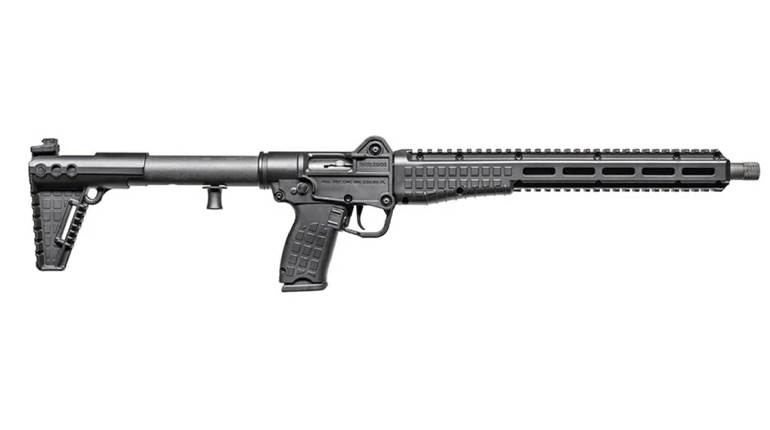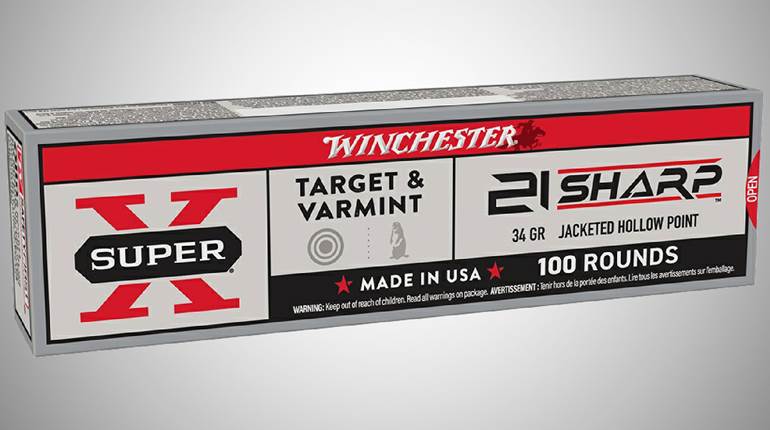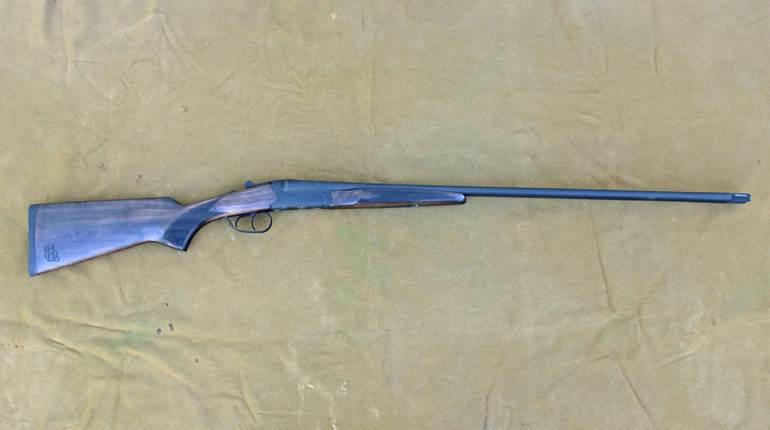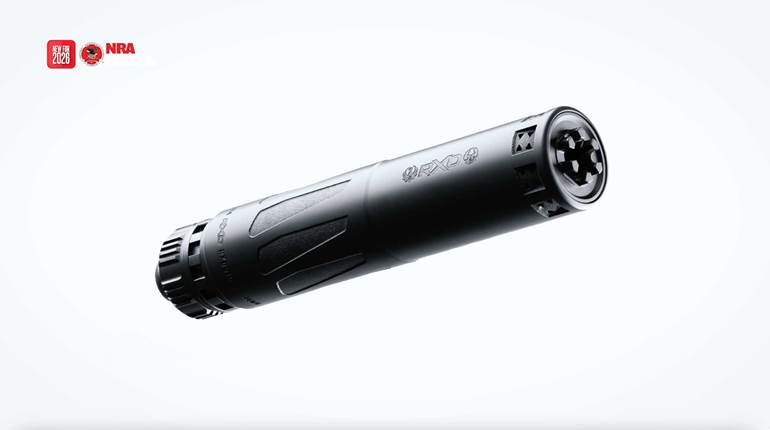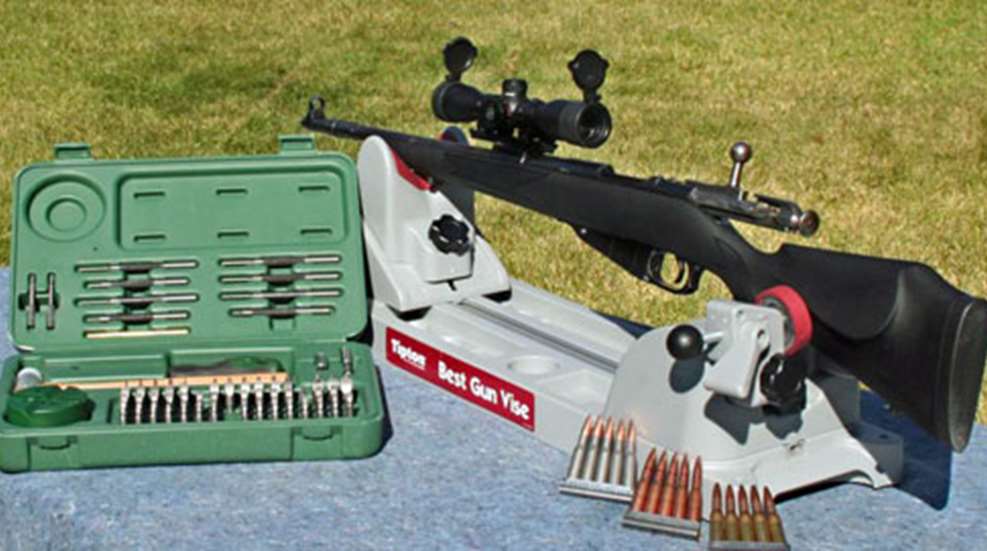
Back in 2001, I received a trip to a local sporting goods store as a Christmas present. My brother-in-law, who worked there at the time, made arrangements for me to hand pick a rifle from among the surplus Russian Mosin-Nagant M44 bolt-actions the company had in stock. Naturally, I was happy to do so.
The Model 1944 (M44) features a 20.5-inch barrel, a side-folding cruciform-spike bayonet and adjustable sights tangent-graduated to 1,000 meters. It’s chambered in the 120-year old 7.62x54 mm R, a rimmed bottleneck rifle cartridge with ballistics comparable to the .308 Win. or .30-06 Sprg. This carbine-length version of the Soviet M38 had a first time production run from 1943 to 1948 when it was issued to a wide range of Red Army soldiers. For years now, surplus M44 rifles, as well as other Mosin-Nagant variants, have been imported for sale on the American market. Their historical background, low price tag and affordable surplus ammunition supply have made them a popular buy.
The rifle that followed me home that day was missing its cleaning rod and the wooden stock showed some wear and tear. However, the blued steel was free of rust, the bore was clean, the bolt cycled smoothly and all of the serial numbered components matched. Soon after, I bought about a 100 rounds of loose 7.62x54 mm R cartridges taken out of a mysterious surplus "sardine" can from the same brother-in-law who sold me the rifle. To this day I still have no idea where that ammunition was made. The corrosive rounds were worth about 9 cents apiece at the time (how I miss those days), so I kept things simple and forked over $10 for them. I had purchased a sturdy, used rifle and 100 rounds of ammunition for under a $100. I couldn't wait to go and try it out.
The M44 was taken on a casual outdoor plinking session with my family. A brother of mine was eager to give it a spin because he had seen the M44 in the war movie Enemy at the Gates, which was released in the spring of that same year. Unfortunately, the shooters gathered for the event that day were not terribly impressed with the M44, and neither was I.
The old, surplus bolt-action did not have very good handling compared to the sleek hunting rifles the family is used to working with. Muzzle heavy and thick around the grip, it had the swing of a pig on a stick. This rifle’s factory trigger was fairly smooth, but the trigger pull felt heavy at 5 pounds, 8 ounces. Then there was the concussive muzzle flash and stout recoil paired with the steel buttplate, which left a distinctive impression when fired.
We would have all been willing to put up with the previously mentioned shortcomings of the M44 if we could have hit anything with it at a distance. Targets set at 100 yards were almost perfectly safe from bullet strikes, while those at 50 yards did not show very impressive groups. Several of the shooters who shouldered the M44 emptied the five-round magazine just once before passing it to the next person on the shooting line. Loud, ugly, heavy on the recoil and not much fun to hold, the M44 was christened "The Pig." The rifle was taken home, carefully cleaned to remove the corrosive cartridge residue, greased and laid to rest at the back of the gun safe where it has been slumbering for more than a decade.
So why have I kept the M44 all of this time? Most of my reasons are sentimental. This is one of the few guns anyone has ever given to me and I enjoy the historical relevance of the rifle. Even though this particular example of the M44 is not a war relic (the receiver is stamped with a 1950's production date) it still has more of a story behind it than just about anything else I own. I also like the rifle’s design. It's the definition of a tough, simple bolt-action chambered for a potent cartridge that's going to go BANG when it's supposed to.
Over the years I’ve wondered if the M44 really got a fair shake on that family shooting day. With a bit of digging, the bag of mysterious 7.62x54 mm R, left over from years ago, was found and re-examined. Just as I remembered, these cartridges were still some of the ugliest ammunition I have every laid eyes on. Dull and sloppily made, they even smelled bad. Not only do the rounds have a lousy lacquer job, some of the cartridge cases have uneven case mouths and wrinkles, yes wrinkles, in the necks and shoulders. Was it reasonable to be so judgmental of the M44's performance when it was filled with bottom-of-the-barrel ammunition?
I've looked over the variety of affordable aftermarket Mosin-Nagant accessories that could be installed to improve the rifle's handling characteristics. The upgrades come in two varieties: Those that require permanent changes to the rifle, and those that don't. Some M44 fans like to dive right into drilling, cutting and re-shaping this affordable surplus rifle to improve performance. Others take umbrage at the idea of chopping up what may be a historically significant heirloom of sorts. For me, I wanted to give “The Pig” an honest chance to shine without pouring too much time or money into what might prove to be a pointless venture. So I took the middle ground approach of gathering up after-market add-ons that would hopefully improve the rifle but would not require any permanent alterations.
If you are just getting started with modifying firearms at home, it’s a good idea to invest in the right tools for the job. A gun vice, like the Tipton Best Gun Vice, and a set of gun-specific tools, like the Weaver Deluxe Kit, go a long way in preventing unnecessary frustration and damage to the gun. Always ensure a gun is completely unloaded and don eye protection before going to work.
The most distracting feature of the M44 was its lack of good handling. The first thing to do was to remove the 10-ounce folding bayonet assembly to lighten the load at the muzzle. The wooden stock, with its bruising steel buttplate, was replaced with an ATI synthetic Monte Carlo-style stock fitted with the company's shock-absorbing Scorpion recoil pad. These two changes reduced the original weight of the rifle (8 pounds, 9 ounces) by only 6 ounces. The weight, however, was better distributed, with most of it near the shoulder instead of up by the muzzle. The shape of the stock, along with the checkering on the grip and fore-end, felt much more familiar.
The M44's factory-installed iron sights are not great. The fact that the hooded front sight post on my rifle leans noticeably to the right does not inspire much confidence. So for accuracy testing, the rear sight was removed and replaced with an S&K Mosin-Nagant Scout Mount (794-000-005WB) scope base, available from Brownells. This base has the advantages of being easy to install and it does not interfere with the cycling of the original bolt. The trade off with using this type of scope base is that it sets the optic out in front of the action instead of on top of the action like most sporting rifles. This means that either a 1X scope or one with long eye relief is required.
I talked to the folks over at Hawke Sport Optics and asked if they had any scopes they would suggest for this project. They recommended their XB 1x32 Crossbow Scope (HK3265), which seemed a bit confusing because of its name. They assured me that the XB scope, with its mono-tube design and fully floating, glass-etched, illuminated, multi-purpose reticle, often finds its way onto turkey hunting shotguns and AR platforms, as well as crossbows. What about an old surplus rifle with the kick of a Missouri mule? They said the XB could take the recoil and a set of weaver rings and flip up caps would already be attached when it arrived.
With the ATI stock and Hawke optic in place, there was one more off-the-shelf upgrade that would hopefully improve the accuracy of the M44. It was a mixed set of 7.62x54 mm R cartridges. Although running several varieties of ammunition through a rifle may not always seem to be affordable or convenient, it can be surprising to see how a change in ammunition brand or bullet weight will affect the cycling, reliability and group sizes of a rifle.
The ugly mystery 7.62x54 mm R was included as test ammunition to set an accuracy base line. But certainly not all surplus ammo for the M44 could be this questionable, so I checked in with Century International Arms. They provide a variety of imported surplus firearms and ammunition, amongst which was a 440-round sardine tin of Russian 7N1 152-grain full-metal-jacket rounds with bi-metal cores. Cracking open the tin revealed beautiful, clean, copper-washed cartridge cases, shiny bullet jackets and red sealant around the primers and the bullet bases. These rounds looked like a night-and-day improvement over the other surplus rounds.
Three more 7.62x54 mm R loads were added. Wolf Performance Ammunition offers a non-corrosive berdan-primed 174-grain full-metal-jacket round in a Polyformance steel-case line, and a 180-grain soft-point boattail load in its brass-cased Gold line. The last cartridge was the steel-cased Hornady Vintage Match 174-grain hollow-point boattail.
The M44’s second-chance test began with sighting in the XB scope at 50 yards. Why not 100 yards? The goal of the exercise was improved accuracy, not calling forth of miracles. Unlike many red-dot scopes, the Hawke XB's black-line reticle provides a traditional set of cross hairs that remain visible with or without the internal laser illumination. This means the scope can still be used if the battery is dead. The XB provides a choice of red or green reticle illumination in five levels of brightness.
Once the scope was sighted in, the rifle was fired from a standing position to get a feel for the ATI synthetic stock. The pig-on-a-stick swing of the M44 was significantly improved. With its familiar sporting rifle shape and molded-in checkering, the synthetic stock made the M44 felt terrific to hold. The rubber buttpad successfully reduced the felt recoil from a brutal kick to a manageable (if stout) shove.
The rifle was benched for formal accuracy testing using five-shot groups fired at 50 yards. The mystery ammo produced the largest group average of 3.17 inches. Cycling these rounds was a little rough at times but there were no marked problems with moving cartridges in or out of the chamber. While Hornady ammunition usually earns high marks for accuracy and function during gun tests, the Vintage Match load and the M44 rifle did not get along so well. Groups averaged 2.42 inches with some spent cases sticking to the chamber enough to make it difficult to cycle the bolt.
The target groups shifted down to an average of 2.07 inches using the brass-cased Wolf Gold load, although it was the toughest round of the bunch to cycle after firing. All of the brass cases stuck to the chamber to some degree or another with a few requiring three or four slaps to the bolt handle in order to open the action. However, the steel-cased Polyformance rounds from Wolf cycled with ease. They took second place for best accuracy with a 1.49-inch average. The best performing ammunition of the test, with problem-free cycling and a 1.41-inch average group size, was the surplus Russian 7N1 full-metal-jacket load. It also produced the best single group of 1.31 inches. I would have expected the commercial-grade hunting loads to produce the best performance. As it turned out, the surplus ammo was the best match for the surplus gun. Go figure.
So was the M44 upgrade worth the investment? I'm going to go ahead and say yes, even though the rifle's long-range accuracy is still limited. The ATI stock and Hawke optic are terrific and the S&K scope base is standing up to the recoil. Now the rifle handles like a bolt-action I can enjoy taking out into the field or to the range for some casual, affordable, high-powered target shooting. Even if it won't ever be useful for long-range applications, it won’t be stuck in the back of the safe for years before it sees daylight again. Best of all, surplus 7.62x54 mm R is still relatively inexpensive (when you can find it).
Could the M44 be used as a close-range game getter, a camp gun or, in a pinch, as a defensive rifle? It can do all of these things well enough to keep them selling like hot cakes. And for those who are wondering, the answer is yes, the ATI Monte Carlo stock will allow the M44 spike bayonet to be re-installed and folded, just in case you need it.












